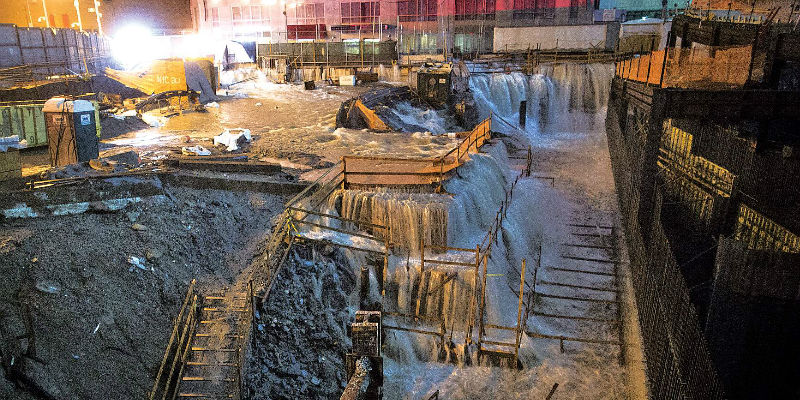‘Sandy’ batters East Coast

GROUND ZERO Sea water floods the Ground Zero construction site where the World Trade Center Twin Towers used to stand in New York City on Monday. Superstorm “Sandy” forced the shutdown of mass transit, schools and financial markets, sending coastal residents fleeing. AP
NEW YORK—As Superstorm “Sandy” churned slowly inland, millions along the US East Coast awoke Tuesday without power or mass transit, and huge swaths of New York City were eerily quiet. At least 23 people were killed in seven states.
The storm that made landfall in New Jersey on Monday evening with hurricane force cut power to at least 7.4 million across the East and put the presidential campaign on hold just one week before Election Day.
New York was among the hardest hit, with its financial heart closed for a second day and seawater cascading into the still-gaping construction pit at the World Trade Center. The storm caused the worst damage in the 108-year history of New York’s subway system, and there was no indication of when the largest US transit system would be rolling again.
But the full extent of the damage in New Jersey was being revealed as morning arrived. Emergency crews fanned out to rescue hundreds.
A hoarse-voiced New Jersey Governor Chris Christie gave bleak news at a morning news conference: Seaside rail lines washed away. No safe place on the state’s barrier islands for him to land. Parts of the coast still under water.
Article continues after this advertisementDevastating sight
Article continues after this advertisement“It is beyond anything I thought I’d ever see,” he said. “It is a devastating sight right now.”
The death toll from Sandy in the US climbed to 23, including several killed by falling trees. Sandy also killed 69 people in the Caribbean before making its way up the Eastern Seaboard.
Airlines canceled more than 12,000 flights. New York City’s three major airports remained closed.
President Barack Obama declared a major disaster in New York and Long Island, making federal funding available to residents of the area. He suspended campaigning again Tuesday.
Trading at the New York Stock Exchange was canceled again Tuesday after the storm sent a nearly 14-foot (4.27-meter) surge of seawater, a record, coursing over its seawalls and highways and into low-lying streets. The water inundated tunnels, subway stations and the electrical system that powers Wall Street and sent hospital patients and tourists scrambling for safety. Skyscrapers swayed and creaked in winds that partially toppled a crane 74 stories above Midtown. A large tanker ship ran aground on the city’s Staten Island.
Fire
A fire raged in a city neighborhood Tuesday morning near the Atlantic Ocean, with 80 to 100 homes destroyed but no deaths reported.
“This will be one for the record books,” said John Miksad, senior vice president for electric operations at Consolidated Edison, which had more than 670,000 customers without power in and around New York City.
In New Jersey, where the superstorm came ashore, a huge swell of water swept over the small town of Moonachie, and authorities struggled to rescue about 800 people, some of them living in a trailer park. Police and fire officials used boats to try to reach the stranded.
“I saw trees not just knocked down but ripped right out of the ground. I watched a tree crush a guy’s house like a wet sponge,” mobile home park resident Juan Allen said.
The massive storm reached well into the Midwest with heavy rain and snow. Chicago officials warned residents to stay away from the Lake Michigan shore as the city prepared for winds of up to 60 mph (96 kph) and waves exceeding 24 feet (7.2 meters) well into Wednesday.
Curiosity turned to concern overnight as New York City residents watched whole neighborhoods disappear into darkness as power was cut. The World Trade Center site was a glowing ghost near the tip of Lower Manhattan. Residents reported seeing no lights but the strobes of emergency vehicles and the glimpses of flashlights in nearby apartments. Lobbies were flooded, cars floated and people started to worry about food.
Monstrous hybrid
As Hurricane Sandy closed in on the Northeast, it converged with a cold-weather system that turned it into a monstrous hybrid of rain and high winds—even bringing snow in West Virginia and other mountainous areas inland.
Just before it made landfall, forecasters stripped Sandy of hurricane status, but the distinction was purely technical, based on its shape and internal temperature. It still packed hurricane-force winds.
While the hurricane’s 90 mph (144 kph) winds registered as only a Category 1 on a scale of five, it packed “astoundingly low” barometric pressure, giving it terrific energy to push water inland, said Kerry Emanuel, a professor of meteorology at MIT.
“We are looking at the highest storm surges ever recorded” in the Northeast, said Jeff Masters, meteorology director for Weather Underground, a private forecasting service.
Tunnels and bridges to Manhattan were shut down, and some flooded.
“We have no idea how long it’s going to take” to restore the transit system, MTA spokeswoman Marjorie Anders said Tuesday.
New York University’s Tisch Hospital was forced to evacuate 200 patients after its backup generator failed. NYU Medical Dean Robert Grossman said patients—among them 20 babies from the neonatal intensive care unit who were on battery-powered respirators—had to be carried down staircases and to dozens of ambulances waiting to take them to other hospitals.
A construction crane atop a $1.5 billion luxury high-rise overlooking Central Park collapsed in high winds and dangled precariously. Thousands of people were ordered to leave several nearby buildings as a precaution.
Reggie Thomas emerged Tuesday morning from his job as a maintenance supervisor at a prison near the overflowing Hudson River, a toothbrush in his front pocket, to find his 2011 Honda with its windows down and a foot (304 millimeters) of water inside.
“It’s totaled,” Thomas said, with a shrug. “You would have needed a boat last night.”